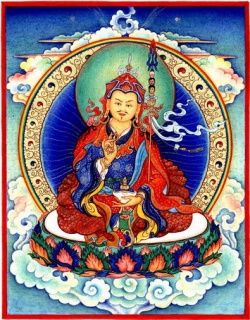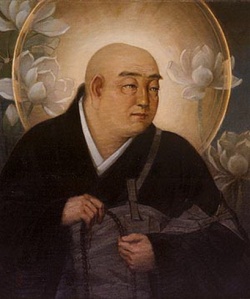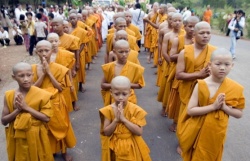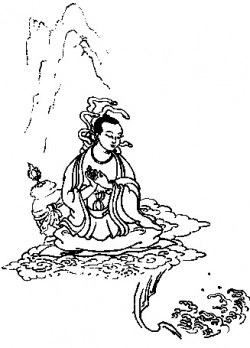Difference between revisions of "Abhidharmakosa Sastra: Introduction by Ven. Dr. Thich Huyen Vi"
| Line 8: | Line 8: | ||
In the following articles we propose to take upon ourselves the task of translation into English the nine chapters of the {{Wiki|Chinese}} [[Abhidharmakosa]] which is entirely based, with negligible interpolations in places, on the original [[Abhidharmakosa]] ([[File:77_3_1.jpg|77_3_1.jpg]] [[A pi ta mo chu she]]) written by [[Vasubandhu]] ([[File:77_3_2.gif|77_3_2.gif]] [[Shih Ch'in]]) in [[Sanskrit]]. The translation work into {{Wiki|Chinese}} was first undertaken and completed by [[Chen-ti]] ([[File:77 3 3.gif|77 3 3.gif]]). But this translation was not verbatim. It gave only the [[idea]], though in verse [[form]] as in the original [[Sanskrit]]. So it failed to gain [[popularity]] in [[China]]. Later on, the same task of translating into {{Wiki|Chinese}} was undertaken by the famous {{Wiki|Chinese}} [[Scholar]] [[Hsuan-tsang]] ([[File:77 3 4.gif|77 3 4.gif]]) who was well versed in the [[Sanskrit]] [[language]]. He had [[attained]] wonderful proficiency in [[Sanskrit]] by studying it in the {{Wiki|Ancient}} [[Nalanda University]] for approximately fourteen years. He successfully completed this difficult task and produced a verbatim {{Wiki|Chinese}} translation of the original [[Abhidharmakosa]] composed by [[Vasubandhu]]. It soon became very popular and received wide [[recognition]] in [[China]]. We are concerned here with this version of the {{Wiki|Chinese}} [[Abhidharmakosa]]. But it will not be out of place if we preface a few lines, with [[Vasubandhu]], the original writer, and his [[Abhidharmakosa]] before discussing the actual work. | In the following articles we propose to take upon ourselves the task of translation into English the nine chapters of the {{Wiki|Chinese}} [[Abhidharmakosa]] which is entirely based, with negligible interpolations in places, on the original [[Abhidharmakosa]] ([[File:77_3_1.jpg|77_3_1.jpg]] [[A pi ta mo chu she]]) written by [[Vasubandhu]] ([[File:77_3_2.gif|77_3_2.gif]] [[Shih Ch'in]]) in [[Sanskrit]]. The translation work into {{Wiki|Chinese}} was first undertaken and completed by [[Chen-ti]] ([[File:77 3 3.gif|77 3 3.gif]]). But this translation was not verbatim. It gave only the [[idea]], though in verse [[form]] as in the original [[Sanskrit]]. So it failed to gain [[popularity]] in [[China]]. Later on, the same task of translating into {{Wiki|Chinese}} was undertaken by the famous {{Wiki|Chinese}} [[Scholar]] [[Hsuan-tsang]] ([[File:77 3 4.gif|77 3 4.gif]]) who was well versed in the [[Sanskrit]] [[language]]. He had [[attained]] wonderful proficiency in [[Sanskrit]] by studying it in the {{Wiki|Ancient}} [[Nalanda University]] for approximately fourteen years. He successfully completed this difficult task and produced a verbatim {{Wiki|Chinese}} translation of the original [[Abhidharmakosa]] composed by [[Vasubandhu]]. It soon became very popular and received wide [[recognition]] in [[China]]. We are concerned here with this version of the {{Wiki|Chinese}} [[Abhidharmakosa]]. But it will not be out of place if we preface a few lines, with [[Vasubandhu]], the original writer, and his [[Abhidharmakosa]] before discussing the actual work. | ||
| − | [[Scholars]] are of the opinion that they were two great [[Acaryas]], [[Vasubandhu]] ([[File:77 3 2.gif|77 3 2.gif]] [[Shih-ch'in]]) and [[Asanga]] ([[File:77 3 6.gif|77 3 6.gif]] [[Wu-chao]]) by [[name]], who flourished in the fourth century A.D. These two were brothers hailing from [[Purusapura]] ([[File:77 3 7.gif|77 3 7.gif]] [[Fu lou sha fu lo]]), which is now known as Peshawara. The [[latter]], that is, [[Asanga]], is said to have acquired complete [[mastery]] over the [[Yogacara]] School ([[File:77 3 8.jpg|77 3 8.jpg]] [[Yu ch'ieh tsung]]) of [[Buddhism]]. But his brother, [[Vasubandhu]], who was initially a [[Sarvastivadin]] ([[File:77 3 9.jpg|77 3 9.jpg]] [[I ch'ieh yu pu]]) later came under the influence of his brother [[Asanga]] and became a [[Yogacarin]]. | + | [[Scholars]] are of the opinion that they were two great [[Acaryas]], [[Vasubandhu]] ([[File:77 3 2.gif|77 3 2.gif]] [[Shih-ch'in]]) and [[Asanga]] ([[File:77 3 6.gif|77 3 6.gif]] [[Wu-chao]]) by [[name]], who flourished in [[the fourth]] century A.D. These two were brothers hailing from [[Purusapura]] ([[File:77 3 7.gif|77 3 7.gif]] [[Fu lou sha fu lo]]), which is now known as Peshawara. The [[latter]], that is, [[Asanga]], is said to have acquired complete [[mastery]] over the [[Yogacara]] School ([[File:77 3 8.jpg|77 3 8.jpg]] [[Yu ch'ieh tsung]]) of [[Buddhism]]. But his brother, [[Vasubandhu]], who was initially a [[Sarvastivadin]] ([[File:77 3 9.jpg|77 3 9.jpg]] [[I ch'ieh yu pu]]) later came under the influence of his brother [[Asanga]] and became a [[Yogacarin]]. |
The [[Abhidharmakosa]], the [[master]] work of [[Vasubandhu]], saw the {{Wiki|light}} of day when belonged to the [[Sarvastivadins]]. Like the [[Theravadins]] ([[File:77 3 10.jpg|77 3 10.jpg]] [[Yuan shih pu]]), the [[Sarvastivadins]] also possessed an [[Abhidharma Pitaka]] ([[File:77 3 11.jpg|77 3 11.jpg]] [[Lun tsang]]) comprising seven Prakaranas. A [[Sangiti]] or [[Buddhist Council]] was held at [[Purusapura]] during the reign of [[emperor]] {{Wiki|Kaniska}} ([[File:77_3_12.jpg|77_3_12.jpg]] [[Chia ni se chia]]) who was a staunch supporter of the [[Sarvastivada School]] of [[Buddhism]]. It was in this [[Buddhist Council]] that the [[Sarvastivadins]] compiled commentaries on their [[Pitakas]]. The commentary on the [[Abhidharma Pitaka]] was known as the [[Vibhasasastra]] ([[File:77_3_13.jpg|77_3_13.jpg]] [[P'i p'o sha lun]]). This work was held in high esteem generally and great importance was [[attached]] to it. For this [[reason]] the authors of this work came to be known as [[Vaibhasikas]] ([[File:77_3_14.jpg|77_3_14.jpg]] [[P'i p'o sha lun shih]]) as {{Wiki|distinct}} from [[Sautrantikas]] ([[File:77_3_15.jpg|77_3_15.jpg]] [[Ching liang chia]]) who laid the foundation for another [[Sarvastivadin]] School. | The [[Abhidharmakosa]], the [[master]] work of [[Vasubandhu]], saw the {{Wiki|light}} of day when belonged to the [[Sarvastivadins]]. Like the [[Theravadins]] ([[File:77 3 10.jpg|77 3 10.jpg]] [[Yuan shih pu]]), the [[Sarvastivadins]] also possessed an [[Abhidharma Pitaka]] ([[File:77 3 11.jpg|77 3 11.jpg]] [[Lun tsang]]) comprising seven Prakaranas. A [[Sangiti]] or [[Buddhist Council]] was held at [[Purusapura]] during the reign of [[emperor]] {{Wiki|Kaniska}} ([[File:77_3_12.jpg|77_3_12.jpg]] [[Chia ni se chia]]) who was a staunch supporter of the [[Sarvastivada School]] of [[Buddhism]]. It was in this [[Buddhist Council]] that the [[Sarvastivadins]] compiled commentaries on their [[Pitakas]]. The commentary on the [[Abhidharma Pitaka]] was known as the [[Vibhasasastra]] ([[File:77_3_13.jpg|77_3_13.jpg]] [[P'i p'o sha lun]]). This work was held in high esteem generally and great importance was [[attached]] to it. For this [[reason]] the authors of this work came to be known as [[Vaibhasikas]] ([[File:77_3_14.jpg|77_3_14.jpg]] [[P'i p'o sha lun shih]]) as {{Wiki|distinct}} from [[Sautrantikas]] ([[File:77_3_15.jpg|77_3_15.jpg]] [[Ching liang chia]]) who laid the foundation for another [[Sarvastivadin]] School. | ||
| Line 37: | Line 37: | ||
{{reflist}} | {{reflist}} | ||
| − | RECORDS OF THE LIFE OF THE VENERABLE [[MASTER]] [[Hsuan Hua|HSUAN HUA]],Part I. "The [[Master]] was 19 years old when his mother passed away. At this [[time]], he left the jhome lofe, taking the [[ten precepts]] of a [[Shramanera]]. He then went to his mother's grave site, and built a 5' x8' hut out of five-inch sorghum stalks. The hut kept out the [[wind]] and [[rain]], but there was little difference between the inside and the outside. Here the [[Master]] observed the {{Wiki|custom}} of filial piety by watching over his mother's grave for a period of three years. Clothed only in a rag robe, he endured the [[bitter]] Manchurian snow and the blazing summer {{Wiki|sun}}. He ate only one meal a day and never slept {{Wiki|lying}} down." An account of the [[Master's]] early years in [[China]]. 96 pages, $3.95. | + | RECORDS OF THE LIFE OF THE VENERABLE [[MASTER]] [[Hsuan Hua|HSUAN HUA]],Part I. "The [[Master]] was 19 years old when his mother passed away. At this [[time]], he left the jhome lofe, taking the [[ten precepts]] of a [[Shramanera]]. He then went to his mother's grave site, and built a 5' x8' hut out of five-inch sorghum stalks. The hut kept out the [[wind]] and [[rain]], but there was little difference between the inside and the outside. Here the [[Master]] observed the {{Wiki|custom}} of filial piety by watching over his mother's grave for a period of three years. Clothed only in a rag robe, he endured the [[bitter]] [[Manchurian]] snow and the blazing summer {{Wiki|sun}}. He ate only one meal a day and never slept {{Wiki|lying}} down." An account of the [[Master's]] early years in [[China]]. 96 pages, $3.95. |
[[BUDDHA]] ROOT FARM, further instructions by the [[Venerable]] [[Master]] [[Hsuan Hua]] in [[meditation]] on the [[name]] of [[Amitabha Buddha]] of the {{Wiki|Western}} [[Land of Ultimate Bliss]]. "The [[water]] flows, the [[wind]] blows, whispering his [[name]]. And when he takes you by the hand to the [[Happy]] Land you'll be so glad you came." 97 pages, $3.00. | [[BUDDHA]] ROOT FARM, further instructions by the [[Venerable]] [[Master]] [[Hsuan Hua]] in [[meditation]] on the [[name]] of [[Amitabha Buddha]] of the {{Wiki|Western}} [[Land of Ultimate Bliss]]. "The [[water]] flows, the [[wind]] blows, whispering his [[name]]. And when he takes you by the hand to the [[Happy]] Land you'll be so glad you came." 97 pages, $3.00. | ||
Revision as of 08:10, 12 November 2020
Abhidharmakosa Sastra
Introduction
by Ven. Dr. Thich Huyen Vi
Ling-shan Monastery
Joinville, Le Ponte, France
In the following articles we propose to take upon ourselves the task of translation into English the nine chapters of the Chinese Abhidharmakosa which is entirely based, with negligible interpolations in places, on the original Abhidharmakosa (![]() A pi ta mo chu she) written by Vasubandhu (
A pi ta mo chu she) written by Vasubandhu (![]() Shih Ch'in) in Sanskrit. The translation work into Chinese was first undertaken and completed by Chen-ti (
Shih Ch'in) in Sanskrit. The translation work into Chinese was first undertaken and completed by Chen-ti (![]() ). But this translation was not verbatim. It gave only the idea, though in verse form as in the original Sanskrit. So it failed to gain popularity in China. Later on, the same task of translating into Chinese was undertaken by the famous Chinese Scholar Hsuan-tsang (
). But this translation was not verbatim. It gave only the idea, though in verse form as in the original Sanskrit. So it failed to gain popularity in China. Later on, the same task of translating into Chinese was undertaken by the famous Chinese Scholar Hsuan-tsang (![]() ) who was well versed in the Sanskrit language. He had attained wonderful proficiency in Sanskrit by studying it in the Ancient Nalanda University for approximately fourteen years. He successfully completed this difficult task and produced a verbatim Chinese translation of the original Abhidharmakosa composed by Vasubandhu. It soon became very popular and received wide recognition in China. We are concerned here with this version of the Chinese Abhidharmakosa. But it will not be out of place if we preface a few lines, with Vasubandhu, the original writer, and his Abhidharmakosa before discussing the actual work.
) who was well versed in the Sanskrit language. He had attained wonderful proficiency in Sanskrit by studying it in the Ancient Nalanda University for approximately fourteen years. He successfully completed this difficult task and produced a verbatim Chinese translation of the original Abhidharmakosa composed by Vasubandhu. It soon became very popular and received wide recognition in China. We are concerned here with this version of the Chinese Abhidharmakosa. But it will not be out of place if we preface a few lines, with Vasubandhu, the original writer, and his Abhidharmakosa before discussing the actual work.
Scholars are of the opinion that they were two great Acaryas, Vasubandhu (![]() Shih-ch'in) and Asanga (
Shih-ch'in) and Asanga (![]() Wu-chao) by name, who flourished in the fourth century A.D. These two were brothers hailing from Purusapura (
Wu-chao) by name, who flourished in the fourth century A.D. These two were brothers hailing from Purusapura (![]() Fu lou sha fu lo), which is now known as Peshawara. The latter, that is, Asanga, is said to have acquired complete mastery over the Yogacara School (
Fu lou sha fu lo), which is now known as Peshawara. The latter, that is, Asanga, is said to have acquired complete mastery over the Yogacara School (![]() Yu ch'ieh tsung) of Buddhism. But his brother, Vasubandhu, who was initially a Sarvastivadin (
Yu ch'ieh tsung) of Buddhism. But his brother, Vasubandhu, who was initially a Sarvastivadin (![]() I ch'ieh yu pu) later came under the influence of his brother Asanga and became a Yogacarin.
I ch'ieh yu pu) later came under the influence of his brother Asanga and became a Yogacarin.
The Abhidharmakosa, the master work of Vasubandhu, saw the light of day when belonged to the Sarvastivadins. Like the Theravadins (![]() Yuan shih pu), the Sarvastivadins also possessed an Abhidharma Pitaka (
Yuan shih pu), the Sarvastivadins also possessed an Abhidharma Pitaka (![]() Lun tsang) comprising seven Prakaranas. A Sangiti or Buddhist Council was held at Purusapura during the reign of emperor Kaniska (
Lun tsang) comprising seven Prakaranas. A Sangiti or Buddhist Council was held at Purusapura during the reign of emperor Kaniska (![]() Chia ni se chia) who was a staunch supporter of the Sarvastivada School of Buddhism. It was in this Buddhist Council that the Sarvastivadins compiled commentaries on their Pitakas. The commentary on the Abhidharma Pitaka was known as the Vibhasasastra (
Chia ni se chia) who was a staunch supporter of the Sarvastivada School of Buddhism. It was in this Buddhist Council that the Sarvastivadins compiled commentaries on their Pitakas. The commentary on the Abhidharma Pitaka was known as the Vibhasasastra (![]() P'i p'o sha lun). This work was held in high esteem generally and great importance was attached to it. For this reason the authors of this work came to be known as Vaibhasikas (
P'i p'o sha lun). This work was held in high esteem generally and great importance was attached to it. For this reason the authors of this work came to be known as Vaibhasikas ( P'i p'o sha lun shih) as distinct from Sautrantikas (
P'i p'o sha lun shih) as distinct from Sautrantikas (![]() Ching liang chia) who laid the foundation for another Sarvastivadin School.
Ching liang chia) who laid the foundation for another Sarvastivadin School.
Vasubandhu scored a tremendous success in summarizing the whole of the Vibhasastra in his masterpiece, the Abhidharmakosa. In other words, the Abhidharmakosa may be said to be a summary of the entire Vibhasasastra. So it is regarded as an introduction to the Abhidharma of the Sarvastivada School. In this respect, it may be compared with the Abhidhammattha Sangaha (![]() Sheng fa chi yao lun) of Anuruddhacariya (
Sheng fa chi yao lun) of Anuruddhacariya (![]() A nou lou to o she li) which is regarded as an introduction to the Theravada School of Buddhism. But there is no denying the fact that Abhidharmakosa is more informative than the Abhidhammattha Sangaha, for it is replete with references to other Buddhist and non-Buddhist schools. For this reason it came to be regarded as a standard work, full of Abhidharmic matters. With the passage of time, it became so popular that Banabhatta who flourished in the 8th century A.D. referred to the popularity of this work in his Harsacarita. According to him even parrots were well versed in Abhidharma and they were heard reciting it[1]. While referring to the Monastery of Divakaramitra, he further says that great devotees and profound scholars of Buddhism were found teaching their disciples the Abhidharmakosa[2]. The Abhidharmakosa maintains even today the same popularity in countries like Mongolia, Tibet, China, Japan, Korea and Vietnam.
A nou lou to o she li) which is regarded as an introduction to the Theravada School of Buddhism. But there is no denying the fact that Abhidharmakosa is more informative than the Abhidhammattha Sangaha, for it is replete with references to other Buddhist and non-Buddhist schools. For this reason it came to be regarded as a standard work, full of Abhidharmic matters. With the passage of time, it became so popular that Banabhatta who flourished in the 8th century A.D. referred to the popularity of this work in his Harsacarita. According to him even parrots were well versed in Abhidharma and they were heard reciting it[1]. While referring to the Monastery of Divakaramitra, he further says that great devotees and profound scholars of Buddhism were found teaching their disciples the Abhidharmakosa[2]. The Abhidharmakosa maintains even today the same popularity in countries like Mongolia, Tibet, China, Japan, Korea and Vietnam.
The Abhidharmakosa includes nine chapters which are as follows:
1. Dhatu-nirdesa: ![]() Fen pieh chieh p'in ti i.
Fen pieh chieh p'in ti i.
2. Indriya-nirdesa: ![]() Fen pieh ken p'in ti erh.
Fen pieh ken p'in ti erh.
3. Lodadhatu-nirdesa:  Fen pieh shih chien p'in ti san.
Fen pieh shih chien p'in ti san.
4. Karma-nirdesa: ![]() Fen pieh yeh p'in ti ssu.
Fen pieh yeh p'in ti ssu.
5. Anusaya-nirdesa: ![]() Fen pieh sui mien p'in ti wu.
Fen pieh sui mien p'in ti wu.
6. Aryapudgala-nirdesa: ![]() Fen pieh hsien sheng p'in ti liu.
Fen pieh hsien sheng p'in ti liu.
7. Jnana-nirdesa: ![]() Fen pieh chi p'in ti ch'i.
Fen pieh chi p'in ti ch'i.
8. Dhyana-nirdesa: ![]() Fen pieh ting p'in ti pa, and
Fen pieh ting p'in ti pa, and
9. Pudgala-nirdesa: ![]() P'o chih wo p'in ti chiu.
P'o chih wo p'in ti chiu.
The first eight chapters are comprised of six hundred karikas. The last, that is, the 9th chapter is in prose. In this chapter the author deals with Pudgalavada and Atma-vada with special reference to the dharma theory.
Footnotes
RECORDS OF THE LIFE OF THE VENERABLE MASTER HSUAN HUA,Part I. "The Master was 19 years old when his mother passed away. At this time, he left the jhome lofe, taking the ten precepts of a Shramanera. He then went to his mother's grave site, and built a 5' x8' hut out of five-inch sorghum stalks. The hut kept out the wind and rain, but there was little difference between the inside and the outside. Here the Master observed the custom of filial piety by watching over his mother's grave for a period of three years. Clothed only in a rag robe, he endured the bitter Manchurian snow and the blazing summer sun. He ate only one meal a day and never slept lying down." An account of the Master's early years in China. 96 pages, $3.95.
BUDDHA ROOT FARM, further instructions by the Venerable Master Hsuan Hua in meditation on the name of Amitabha Buddha of the Western Land of Ultimate Bliss. "The water flows, the wind blows, whispering his name. And when he takes you by the hand to the Happy Land you'll be so glad you came." 97 pages, $3.00.



